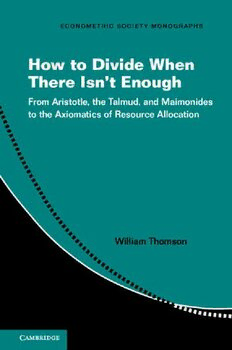Table Of ContentCambridge University Press
978-1-107-19462-5 — How to Divide When There Isn't Enough
William Thomson
Frontmatter
More Information
HowtoDivideWhenThereIsn’tEnough
How to Divide When There Isn’t Enough develops a rigorous yet accessible pre-
sentation of the state of the art for the adjudication of conflicting claims and the
theoryoftaxation.Itcoversallaspectsonemaywishtoknowaboutclaimsprob-
lems: the most important rules, the most important axioms, and how these two
sets are related. More generally, it also serves as an introduction to the modern
theoryofeconomicdesign,whichinthelasttwentyyearshasrevolutionizedmany
areasofeconomics,generatingawiderangeofapplicableallocationrulesthathave
improvedpeople’slivesinmanyways.Indevelopingthetheory,thebookemploys
avarietyoftechniquesthatwillappealtobothexpertsandnonexperts.Compiling
decadesofresearchintoasingleframework,WilliamThomsonprovidesnumerous
applicationsthatwillopenalargenumberofavenuesforfutureresearch.
WilliamThomsonistheElmerMillimanProfessorofEconomicsattheUniversity
of Rochester. He is the author of several books including A Guide for the Young
Economist,whichhasappearedinfourtranslations,andoveronehundredarticles.
In2001,hewontheUniversityAwardforExcellenceinGraduateTeachingatthe
UniversityofRochester.HeisaFellowoftheEconometricSociety,theSocietyfor
EconomicTheory,andtheGameTheorySociety.
© in this web service Cambridge University Press www.cambridge.org
Cambridge University Press
978-1-107-19462-5 — How to Divide When There Isn't Enough
William Thomson
Frontmatter
More Information
EconometricSocietyMonographsSeries
Editors:
AndreaPrat,ColumbiaUniversity
StéphaneBonhomme,UniversityofChicago
TheEconometricSocietyisaninternationalsocietyfortheadvancementofeconomictheoryin
relation to statistics andmathematics. The EconometricSociety Monographseries is designed
to promote the publication of original research contributions of high quality in mathematical
economicsandtheoreticalandappliedeconometrics.
BooksintheSeries
O.Compte&A.Postlewaite,IgnoranceandUncertainty,2019
I.Molchanov&F.Molinari,RandomSetsinEconometrics,2018
B.Honoré,A.Pakes,M.Piazzesi,&L.Samuelson(eds.),AdvancesinEconomicsand
Econometrics:EleventhWorldCongress,Vols.I&II,2017
S.Maurer,OntheShouldersofGiants:ColleaguesRememberSuzanneScotchmer’s
ContributionstoEconomics,2017
C.P.Chambers&F.Echenique,RevealedPreferenceTheory,2016
J.-F.Mertens,S.Sorins,&S.Samir,RepeatedGames,2015
C.Hsiao,AnalysisofPanelData:3rded.,2014
C.Cameron&P.Trivedi,RegressionAnalysisofCountData,2nded.,2013
A.Harvey,DynamicModelsforVolatilityandHeavyTails,withApplicationstoFinancialand
EconomicTimeSeries,2013
D.Acemoglu,M.Areilano,&E.Dekel(eds.),AdvancesinEconomicsandEconometrics:
TheoryandApplications,TenthWorldCongress,Vols.I,II,&III,2013
M.Fleurbaey&F.Maniquet,ATheoryofFairnessandSocialJustice,2011
R.Vohra,MechanismDesign:ALinearProgrammingApproach,2011
K.Samphantharak&R.Townsend,HouseholdsasCorporateFirms:AnAnalysisofHousehold
FinanceUsingIntegratedHouseholdSurveysandCorporateFinancialAccounting,2009
I.Gilboa,TheoryofDecisionunderUncertainty,2009
F.Vega-Redondo,ComplexNetworks,2007
R.Blundell,W.Newey,&T.Persson,(eds.),AdvancesinEconomicsandEconometrics:Theory
andApplications,NinthWorldCongress,Vols.I,II,&III,2006
J.Roemer,Democracy,Education,andEquality,2006
C.Blackorby,W.Bossert,&D.Donaldson,PopulationIssuesinSocialChoiceTheory,Welfare
EconomicsandEthics,2005
R.Koenker,QuantileRegression,2005
C.Hsiao,AnalysisofPanelData,2nded.,2003
M.Dewatripont,L.P.Hausen,&S.J.Turnovsky(eds.),AdvancesinEconomicsand
Econometrics:TheoryandApplications,EighthWorldCongress,Vols.I,II,&III,2003
E.Ghysels,N.Swanson,&M.Watson(eds.),EssaysinEconometrics:CollectedPapersofClive
W.J.Granger,Vols.I&II,2001
S.Strøm(ed.),EconometricsandEconomicTheoryinthe20thCentury:TheRagnarFrisch
CentennialSymposium,1999
A.C.Cameron&P.K.Trivedi,RegressionAnalysisofCount-Data,1998
D.Jacobs,E.Kalai,&M.Kamien(eds.),FrontiersofResearchinEconomicTheory:TheNancy
L. SchwartzMemorialLectures,1998
D.M.Kreps&K.F.Wallis(eds.),AdvancesinEconomicsandEconometrics:Theoryand
Applications,SeventhWorldCongress,Vols.I,II,&III,1997
R.Guesnerie,AContributiontothePureTheoryofTaxation,1995
C.Sims(ed.),AdvancesinEconometrics,SixthWorldCongress,Vols.I&II,1994
Continuedonpagefollowingtheindex
© in this web service Cambridge University Press www.cambridge.org
Cambridge University Press
978-1-107-19462-5 — How to Divide When There Isn't Enough
William Thomson
Frontmatter
More Information
How to Divide
When There Isn’t Enough
From Aristotle, the Talmud, and
Maimonides to the Axiomatics of
Resource Allocation
William Thomson
UniversityofRochester
© in this web service Cambridge University Press www.cambridge.org
Cambridge University Press
978-1-107-19462-5 — How to Divide When There Isn't Enough
William Thomson
Frontmatter
More Information
UniversityPrintingHouse,CambridgeCB28BS,UnitedKingdom
OneLibertyPlaza,20thFloor,NewYork,NY10006,USA
477WilliamstownRoad,PortMelbourne,VIC3207,Australia
314–321,3rdFloor,Plot3,SplendorForum,JasolaDistrictCentre,
NewDelhi–110025,India
79AnsonRoad,#06–04/06,Singapore079906
CambridgeUniversityPressispartoftheUniversityofCambridge.
ItfurtherstheUniversity’smissionbydisseminatingknowledgeinthepursuitof
education,learning,andresearchatthehighestinternationallevelsofexcellence.
www.cambridge.org
Informationonthistitle:www.cambridge.org/9781107194625
DOI:10.1017/9781108161107
(cid:2)c WilliamThomson2019
Thispublicationisincopyright.Subjecttostatutoryexception
andtotheprovisionsofrelevantcollectivelicensingagreements,
noreproductionofanypartmaytakeplacewithoutthewritten
permissionofCambridgeUniversityPress.
Firstpublished2019
PrintedintheUnitedKingdombyTJInternationalLtd,PadstowCornwall
AcataloguerecordforthispublicationisavailablefromtheBritishLibrary.
LibraryofCongressCataloging-in-PublicationData
Names:Thomson,William,1949–author.
Title:Howtodividewhenthereisn’tenough:fromAristotle,theTalmud,
andMaimonidestotheaxiomaticsofresourceallocation/WilliamThomson,
UniversityofRochester.
Description:Cambridge,UnitedKingdom;NewYork,NY:CambridgeUniversity
Press,2019.|Series:EconometricSocietymonographseries
Identifiers:LCCN2019006500|ISBN9781107194625
Subjects:LCSH:Scarcity–Econometricmodels.|Resource
allocation–Econometricmodels.
Classification:LCCHB801.T52852019|DDC330.01/5195–dc23
LCrecordavailableathttps://lccn.loc.gov/2019006500
ISBN978-1-107-19462-5Hardback
ISBN978-1-316-64644-1Paperback
CambridgeUniversityPresshasnoresponsibilityforthepersistenceoraccuracyof
URLsforexternalorthird-partyinternetwebsitesreferredtointhispublication
anddoesnotguaranteethatanycontentonsuchwebsitesis,orwillremain,
accurateorappropriate.
© in this web service Cambridge University Press www.cambridge.org
Cambridge University Press
978-1-107-19462-5 — How to Divide When There Isn't Enough
William Thomson
Frontmatter
More Information
To Lisa and Rachèle
© in this web service Cambridge University Press www.cambridge.org
Cambridge University Press
978-1-107-19462-5 — How to Divide When There Isn't Enough
William Thomson
Frontmatter
More Information
© in this web service Cambridge University Press www.cambridge.org
Cambridge University Press
978-1-107-19462-5 — How to Divide When There Isn't Enough
William Thomson
Frontmatter
More Information
Contents
ListofFigures pagexii
ListofTables xix
Acknowledgments xx
GeneralNotation xxi
1 Introduction 1
1.1 ClaimsProblems 1
1.2 TheModel 3
1.3 TwoPuzzlesintheTalmud 9
1.4 ThreeApproaches 11
1.4.1 DirectApproach 12
1.4.2 AxiomaticApproach 12
1.4.3 Game-TheoreticApproach 15
1.5 HistoricalNote 16
1.6 RoadMap 16
1.7 HowtoUseThisBook 17
1.8 ConcludingComment 18
2 InventoryofDivisionRules 21
2.1 AnInventoryofRules 22
2.1.1 ProportionalRule 22
2.1.2 ConstrainedEqualAwardsRule 23
2.1.3 ConstrainedEqualLossesRule 26
2.1.4 Concede-and-Divide 28
2.1.5 Piniles’Rule 31
2.1.6 TalmudRule 32
2.1.7 ConstrainedEgalitarianRule 34
2.1.8 RandomArrivalRule 37
2.1.9 MinimalOverlapRule 38
2.1.10 RuleBasedonRandomStakes 43
vii
© in this web service Cambridge University Press www.cambridge.org
Cambridge University Press
978-1-107-19462-5 — How to Divide When There Isn't Enough
William Thomson
Frontmatter
More Information
viii Contents
2.2 FamiliesofRules 45
2.2.1 SequentialPriorityFamily 45
2.2.2 Young’sFamily 46
2.2.3 ICIandCICFamilies 53
2.3 Summary 60
3 BasicPropertiesofDivisionRules 62
3.1 Balance 62
3.2 Continuity 63
3.3 Homogeneity 64
3.4 LowerandUpperBoundsonAwardsandLosses 65
3.4.1 DefiningBounds 65
3.4.2 RecursiveAssignmentofLowerBounds 72
3.5 Conditional Full Compensation, Conditional Null
Compensation,andRelatedProperties 75
3.6 SymmetryProperties 79
3.7 OrderPreservationProperties 89
4 MonotonicityProperties 94
4.1 EndowmentMonotonicityandRelatedProperties 95
4.2 ClaimMonotonicityandRelatedProperties 105
4.3 InverseSetsAxioms 115
5 ClaimsTruncationInvarianceandMinimalRightsFirst 118
5.1 ClaimsTruncationInvariance 119
5.2 MinimalRightsFirst 123
6 CompositionDownandCompositionUp 131
6.1 CompositionDown 131
6.2 CompositionUp 140
7 Duality 157
7.1 DualityforRules 157
7.2 DualityforProperties 165
7.3 DualityforTheorems 171
7.4 Characterizations 172
8 OtherInvarianceProperties 182
8.1 NoAdvantageousTransfer 182
8.2 ClaimsSeparabilityandVariants 184
8.3 ConvexityandAdditivityProperties 187
8.4 RationalizingRulesasMaximizersofBinaryRelations 195
9 Operators 200
9.1 ClaimsTruncationOperator 200
© in this web service Cambridge University Press www.cambridge.org

